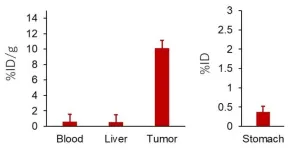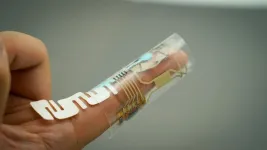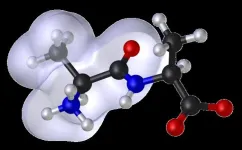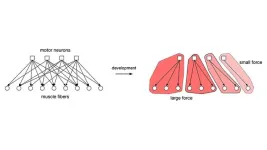(Press-News.org) A modeling study suggests that one-sided interspecies cooperation can spontaneously emerge and persist over time, despite only one species benefitting. Evolutionary game theory, and the prisoner’s dilemma in particular, are often used to model the evolution of cooperation within a single species. In the prisoner’s dilemma, both parties benefit by cooperating, but the greatest benefit is earned by a defector who plays with a cooperator. The temptation to cheat tends to push players towards defection, even though mutual defection returns a lower payoff to both parties. Christoph Hauert and György Szabó used the prisoner’s dilemma game to model inter-species cooperation, taking as their inspiration mutualisms, such as the relationships between flowering plants and their pollinators or nitrogen-fixing bacteria and the plants in which they live. The authors set up a model of cooperation between two identical species of equal population size with identical generation times situated on two separate lattices, such that interactions occur between species while competition is fiercest within species. This setup could represent the arrangement of microbes in a biofilm. In the model, the individuals are sessile, and each compete with four neighbors of the same species and potentially assist five neighbors of the other species. “Fitter” individuals, in terms of points won, reproduce more often. By adjusting the cost-to-benefit ratio of cooperation, various dynamic patterns of cooperation and defection are produced. For some values of the cost-to-benefit ratio, the authors find an unexpected pattern in which one species consistently cooperates, donating to the other species at a cost to itself, and yet its partner consistently defects, failing to reciprocate. According to the authors, under some conditions, natural selection may favor asymmetric states where one species exploits the other.
A tutorial of the model is available at https://wiki.evoludo.org/index.php?title=Mutualisms:_cooperation_between_species.
END
Natural selection may create inter-species exploitation
2024-09-03
ELSE PRESS RELEASES FROM THIS DATE:
Targeted cancer therapies: Getting radioactive atoms to accumulate in tumors
2024-09-03
Prostate cancer is the second most common cancer among men worldwide, following lung cancer. In the United States alone, nearly 300,000 new cases are diagnosed annually. While reducing testosterone and other male hormones can be an effective treatment for prostate cancer, this approach becomes ineffective once the disease progresses to metastatic castration-resistant prostate cancer (mCRPC). At this stage, the cancer advances quickly and becomes resistant to conventional hormonal therapies and chemotherapy.
A clever strategy for fighting mCRPC is to exploit the ...
Gigantic asteroid impact shifted the axis of Solar System's biggest moon
2024-09-03
Around 4 billion years ago, an asteroid hit the Jupiter moon Ganymede. Now, a Kobe University researcher realized that the Solar System's biggest moon's axis has shifted as a result of the impact, which confirmed that the asteroid was around 20 times larger than the one that ended the age of the dinosaurs on Earth, and caused one of the biggest impacts with clear traces in the Solar System.
Ganymede is the largest moon in the Solar System, bigger even than the planet Mercury, and is also interesting for the liquid water oceans beneath its icy surface. Like the Earth’s moon, it is tidally locked, meaning that it always shows the ...
Finger wrap uses sweat to provide health monitoring at your fingertips—literally
2024-09-03
A sweat-powered wearable has the potential to make continuous, personalized health monitoring as effortless as wearing a Band-Aid. Engineers at the University of California San Diego have developed an electronic finger wrap that monitors vital chemical levels—such as glucose, vitamins, and even drugs—present in the same fingertip sweat from which it derives its energy.
The advance was published Sept. 3 in Nature Electronics by the research group of Joseph Wang, a professor in the Aiiso Yufeng Li Family Department of Chemical and Nano Engineering ...
Large sharks may be hunting each other – and scientists know because of a swallowed tracking tag
2024-09-03
Who killed the pregnant porbeagle?
In a marine science version of the game Cluedo, researchers from the US have now accused a larger shark, with its deciduous triangular teeth, in the open sea southwest of Bermuda. This scientific whodunnit is published in Frontiers in Marine Science.
“This is the first documented predation event of a porbeagle shark anywhere in the world,” said lead author Dr Brooke Anderson, a former graduate student at Arizona State University.
“In one event, the population not only lost a reproductive female that could contribute to population growth, but it also lost all her developing ...
Can’t stop belching? Dietary habits or disease could be the reason
2024-09-03
Belching is a common bodily function, but when it escalates to a level that interferes with daily life, it is defined as belching disorders. International surveys have reported that approximately 1% of adults have belching disorders, but the percentage in Japan and the factors involved often elude medical professionals.
To examine the relationship between the rate of belching disorders, comorbidities, and lifestyles in Japan, a research team led by Professor Yasuhiro Fujiwara of Osaka Metropolitan University’s Graduate School of Medicine ...
Exploring peptide clumping for improved drug and material solutions
2024-09-03
Scientists from China have investigated how short peptide chains aggregate together in order to deepen our understanding of the process, which is crucial for drug stability and material development. Their study, published in JACS Au, provides valuable insights into how short proteins called peptides interact, fold, and function. These findings have significant implications for medicine, material science, and biotechnology.
Peptides are short chains of amino acids that play essential roles in the body by building structures, speeding up chemical reactions, and supporting our immune system. The specific function of a protein is determined by how its amino acids interact with each other and ...
Young adults let down by ‘postcode lottery’ for ADHD treatment - national survey
2024-09-03
A national survey conducted as part of University of Exeter research has found huge variation in treatment for ADHD, highlighting the struggle many young adults face once they turn 18.
Researchers have warned that the current system is failing many young adults as they transition from children’s to adult’s services - suddenly finding themselves unable to access treatment because services do not link up effectively.
More than 750 people from across the country – including commissioners, healthcare professionals working ...
False-positive mammography result may discourage women from subsequent screening
2024-09-02
Embargoed for release until 5:00 p.m. ET on Monday 2 September 2024
Annals of Internal Medicine Tip Sheet
@Annalsofim
Below please find summaries of new articles that will be published in the next issue of Annals of Internal Medicine. The summaries are not intended to substitute for the full articles as a source of information. This information is under strict embargo and by taking it into possession, media representatives are committing to the terms of the embargo not only on their own behalf, but also on behalf of the organization they represent.
----------------------------
1. ...
False-positive mammograms discourage some women from future screenings
2024-09-02
Early detection of breast cancer through mammography screening continues to save lives. However, abnormal findings on mammograms can lead to women being recalled for additional imaging and biopsies, many of which turn out to be “false positives,” meaning they do not result in a cancer diagnosis. False positives can also have financial implications for patients and cause significant emotional anxiety.
A major, new study led by the UC Davis Comprehensive Cancer Center has found that women who received a false-positive result that required additional imaging or biopsy were less likely to return ...
The nervous system’s matchmaker
2024-09-02
When you ask a rideshare app to find you a car, the company’s computers get to work. They know you want to reach your destination quickly. They know you’re not the only user who needs a ride. And they know drivers want to minimize idle time by picking up someone nearby. The computer’s job, says Cold Spring Harbor Laboratory Associate Professor Saket Navlakha, is to pair drivers with riders in a way that maximizes everyone’s happiness.
Computer scientists like Navlakha call this bipartite matching. It’s the same task handled by systems pairing organ donors with transplant candidates, medical students with residency ...






